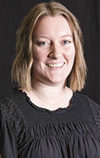I recently heard an interesting analogy: Not testing your hay can put your cows on a nutritional roller coaster. While some may enjoy the thrill of a roller coaster and the anticipation of the next flip or turn, for cattle nutrition and the rumen environment, slow and steady is the way to go. Cattle diets should provide an appropriate and consistent amount of nutrients according to the needs of the animal.
All hay is not created equal. A hay “lot” consists of hay made from the same field and cutting – essentially, all hay in a lot has been managed the same way and therefore should be similar in quality. So it makes sense that hay cut and baled in late April is probably different than hay harvested for the first time at the end of May, or that hay cut every five weeks is different from hay cut every eight weeks.
Say you sampled the first few rolls of hay stored for the winter. The analysis came back with 57% total digestible nutrients (TDN) and 12% crude protein. You concluded that you should feed 5 to 6 pounds per head per day of whole cottonseed to ensure there is enough energy in the diet. November rolls around and the fall-calving cows have started to drop body condition. This could be because you have gotten into a different lot of hay, one that hasn’t been representatively sampled as a part of your planning. Turns out, this next batch of hay has a TDN of 52% and crude protein of 8%, meaning the supplementation strategy should be adjusted. The cattle have reached the peak on the roller coaster of hay quality and now are on the downhill ride.
Here are a few key takeaways:
- Manage: Try to cut hay at optimal quality. Store hay in a barn, or at least covered and off the ground to reduce storage loss. Test each individual lot of hay and then create a hay “inventory.”
- Match: Know how cattle needs change throughout different stages of production and when you can get away with lower-quality hay versus needing higher-quality hay. Select which bales of hay to feed based on quality that closely matches the requirements of your animals.
- Maximize: Be strategic in your winter feeding plan. Create a well-balanced supplementation plan based on hay analyses. Feeding precisely the amount of nutrients needed will be the most economical way to meet the requirements of the cow herd.








